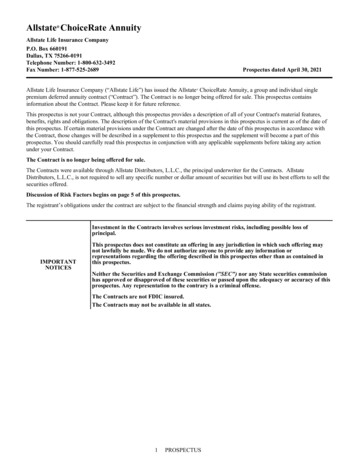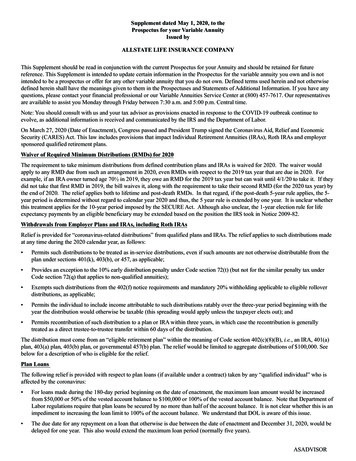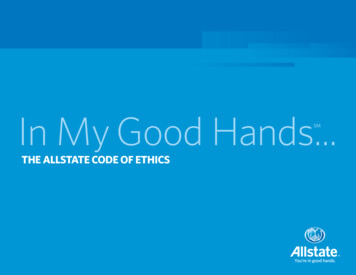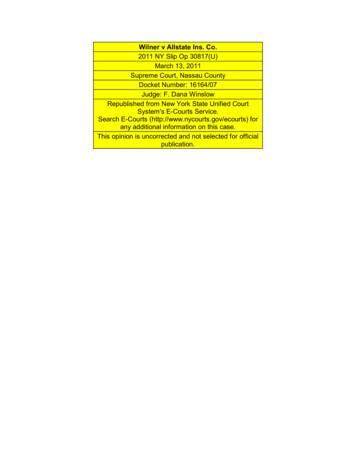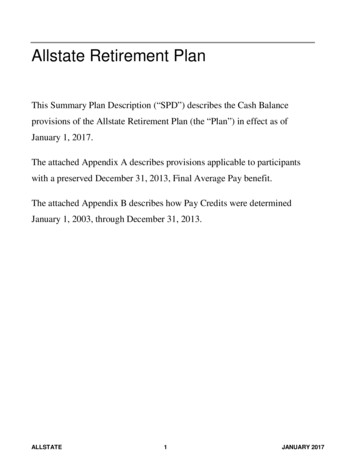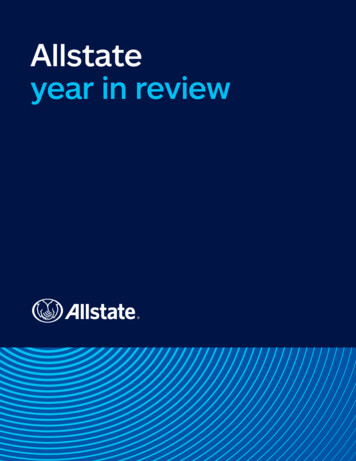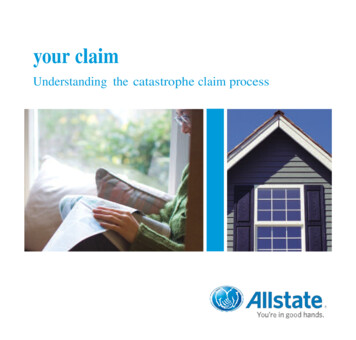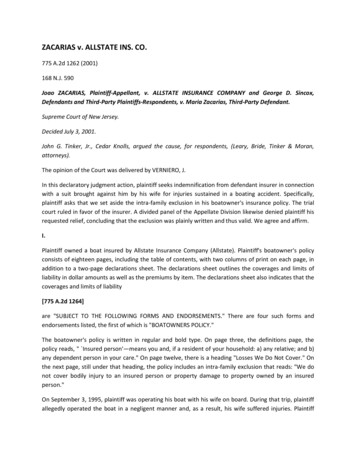
Transcription
ZACARIAS v. ALLSTATE INS. CO.775 A.2d 1262 (2001)168 N.J. 590Joao ZACARIAS, Plaintiff-Appellant, v. ALLSTATE INSURANCE COMPANY and George D. Sincox,Defendants and Third-Party Plaintiffs-Respondents, v. Maria Zacarias, Third-Party Defendant.Supreme Court of New Jersey.Decided July 3, 2001.John G. Tinker, Jr., Cedar Knolls, argued the cause, for respondents, (Leary, Bride, Tinker & Moran,attorneys).The opinion of the Court was delivered by VERNIERO, J.In this declaratory judgment action, plaintiff seeks indemnification from defendant insurer in connectionwith a suit brought against him by his wife for injuries sustained in a boating accident. Specifically,plaintiff asks that we set aside the intra-family exclusion in his boatowner's insurance policy. The trialcourt ruled in favor of the insurer. A divided panel of the Appellate Division likewise denied plaintiff hisrequested relief, concluding that the exclusion was plainly written and thus valid. We agree and affirm.I.Plaintiff owned a boat insured by Allstate Insurance Company (Allstate). Plaintiff's boatowner's policyconsists of eighteen pages, including the table of contents, with two columns of print on each page, inaddition to a two-page declarations sheet. The declarations sheet outlines the coverages and limits ofliability in dollar amounts as well as the premiums by item. The declarations sheet also indicates that thecoverages and limits of liability[775 A.2d 1264]are "SUBJECT TO THE FOLLOWING FORMS AND ENDORSEMENTS." There are four such forms andendorsements listed, the first of which is "BOATOWNERS POLICY."The boatowner's policy is written in regular and bold type. On page three, the definitions page, thepolicy reads, " Insured person'—means you and, if a resident of your household: a) any relative; and b)any dependent person in your care." On page twelve, there is a heading "Losses We Do Not Cover." Onthe next page, still under that heading, the policy includes an intra-family exclusion that reads: "We donot cover bodily injury to an insured person or property damage to property owned by an insuredperson."On September 3, 1995, plaintiff was operating his boat with his wife on board. During that trip, plaintiffallegedly operated the boat in a negligent manner and, as a result, his wife suffered injuries. Plaintiff
submitted a claim to Allstate on behalf of his wife, but the carrier disclaimed coverage based on theintra-family exclusion in the policy. Thereafter, plaintiff's wife sued plaintiff for her injuries.Allstate provided a defense for plaintiff under a reservation of rights. Plaintiff then filed this declaratoryjudgment action against Allstate seeking to void the intra-family exclusion. In the alternative, plaintiffsought to compel the carrier to indemnify him because of the insurer's alleged failure to inform plaintiffof the exclusion. The underlying injury case and the declaratory action were consolidated. Both partiesfiled motions for summary judgment. The trial court denied plaintiff's motion and granted defendant'smotion, thereby dismissing plaintiff's action.With one member of the panel dissenting, the Appellate Division affirmed the trial court's disposition.Zacarias v. Allstate Ins. Co., 330 N.J.Super. 231, 749 A.2d 394 (App.Div.2000). The majority held that thepolicy was free of ambiguity and was to be given its "plain and ordinary meaning." Id. at 234, 749 A.2d394. The dissenter concluded that the policy should be read to conform to the reasonable expectationsof the insured, explaining that plaintiff had purchased insurance with the intention of covering all legallycognizable liability claims arising from the use of his boat. Id. at 236-37, 749 A.2d 394 (Pressler, P.J.A.D.,dissenting). Plaintiff filed this appeal as of right. R. 2:2-1(a).II.A.We give special scrutiny to insurance contracts because of the stark imbalance between insurancecompanies and insureds in their respective understanding of the terms and conditions of insurancepolicies. Gibson v. Callaghan, 158 N.J. 662, 669, 730 A.2d 1278 (1999). In the first instance, the words ofan insurance policy are to be given their plain, ordinary meaning. "In the absence of any ambiguity,courts should not write for the insured a better policy of insurance than the one purchased." Id. at 670,730 A.2d 1278 (quotation and citation omitted). However, "[i]nsurance policies are contracts ofadhesion and as such, are subject to special rules of interpretation." Ibid. (citing Longobardi v. Chubb Ins.Co., 121 N.J. 530, 537, 582 A.2d 1257 (1990); Meier v. N.J. Life Ins. Co., 101 N.J. 597, 611-12, 503 A.2d862 (1986)). When there is ambiguity in an insurance contract, courts interpret the contract to comportwith the reasonable expectations of the insured, even if a close reading of the written text reveals acontrary meaning. Id. at 671, 503 A.2d 862. " The objectively reasonable expectations of applicants andintended beneficiaries regarding the terms of insurance contracts will be honored even thoughpainstaking study of the policy provisions[775 A.2d 1265]would have negated those expectations.'" Sparks v. St. Paul Ins. Co., 100 N.J. 325, 338-39, 495 A.2d 406(1985) (quoting R. Keeton, Insurance Law 351 (1971); R. Keeton, Insurance Law Rights at Variance withPolicy Provisions, 83 Harv. L.Rev. 961, 967 (1970)).That fundamental rule of interpretation, known as the doctrine of reasonable expectations, has longbeen a part of our law. This Court invoked the doctrine in Kievit v. Loyal Protective Life Insurance Co., 34
N.J. 475, 170 A.2d 22 (1961). In Kievit, the plaintiff owned an accident insurance policy that coveredlosses " resulting directly and independently of all other causes from accidental bodily injuries,'" but notlosses " resulting from or contributed to by any disease or ailment.'" Id. at 477, 170 A.2d 22. While atwork, the plaintiff sustained an injury that activated or caused Parkinson's disease-like symptoms overhis entire body. Id. at 478, 170 A.2d 22. The symptoms completely disabled him. Ibid. The insurercompensated the plaintiff for several months, then stopped payment on the ground that a pre-existingdisease or ailment was contributing to his losses. Ibid.The Court held that a pre-existing, dormant condition was not a disqualifier under the terms of thecontract. Id. at 490-91, 170 A.2d 22. The Court reasoned that the distinction between accidental injuriesthat cause disability on their own and accidental injuries that trigger pre-existing ailments was too finefor a layperson to anticipate in advance of purchasing an insurance policy. "[Insureds] should not besubjected to technical encumbrances or to hidden pitfalls and their policies should be construed liberallyin their favor to the end that coverage is afforded to the full extent that any fair interpretation willallow.'" Id. at 482, 170 A.2d 22 (citation omitted). The Court also noted:[T]he court's goal in construing an accident insurance policy is to effectuate the reasonable expectationsof the average member of the public who buys it; he may hardly be expected to draw any subtle orlegalistic distinctions based on the presence or absence of the exclusionary clause for he pays premiumsin the strong belief that if he sustains accidental injury which results (in the commonly accepted sense)in his disability he will be indemnified and not left empty-handed on the company's assertion that hisdisability was caused or contributed to by a latent disease or condition of which he was unaware andwhich did not affect him before the accident.[Id. at 488-89, 170 A.2d 22.]The Court reached a similar conclusion in Gerhardt v. Continental Insurance Cos., 48 N.J. 291, 225 A.2d328 (1966). There, the plaintiff purchased a homeowner's policy. Id. at 292, 225 A.2d 328. The languageof the policy excluded a worker's compensation claim by a domestic employee. To discover thatexclusion, the insured would have had to cross-reference several provisions deep into the contract. Id.at 293-94, 225 A.2d 328. Citing Kievit, the Court concluded that the plaintiff's reasonable expectation ofcoverage against a worker's compensation claim should be fulfilled. Id. at 300, 225 A.2d 328. In so doing,we described the confusing nature of the policy, observing that "[it] continue[d] over many printedpages in small print and with much obscure terminology." Id. at 293, 225 A.2d 328. We also stated:[775 A.2d 1266][T]he exclusionary clause in the policy before us was neither conspicuous nor plain and clear. [O]nly avery hardy soul would have plowed through all of the fine print here in an effort to understand themany terms and conditions. [I]t seems highly unlikely that the ordinary insured would have sounderstood it on his or her own reading.[Id. at 298, 299, 225 A.2d 328.]
In other instances, this Court has found no ambiguity in insurance contracts and thus enforced theirterms as written. One such case is Di Orio v. New Jersey Manufacturers Insurance Co., 79 N.J. 257, 398A.2d 1274 (1979). In that case, the plaintiff was the insured's son who used a vehicle, owned by theinsured's business and furnished for the insured's regular use, as a second family car. Id. at 266, 398A.2d 1274. The insurance policy for the family car covered the plaintiff when he drove a "non-ownedautomobile," which was defined as " an automobile . not owned by or furnished for the regular use ofeither the named insured or any relative[.]'" Id. at 263, 398 A.2d 1274. The insured's son drove thebusiness-owned car and had an accident in which an infant was badly injured. Id. at 261, 398 A.2d 1274.The insurer disclaimed coverage because, it argued, the policy unambiguously excepted non-owned carsthat the insured's family (either the insured or his son) regularly used. Ibid. The plaintiff argued that thepolicy should have covered the vehicle when he drove it because he did not regularly use the businessowned car. Id. at 268-69, 398 A.2d 1274. The plaintiff claimed that the policy was ambiguous and shouldbe construed consistent with the insured's reasonable expectations. Id. at 267, 398 A.2d 1274.The Court held in favor of the insurer, concluding that the doctrine of reasonable expectations did notapply. Id. at 269-70, 398 A.2d 1274. The coverage and the definition provisions relating to "non-owned"automobiles were on the first page of the policy, making them clear and conspicuous to the insured. Id.at 270, 398 A.2d 1274. The Court found that the non-owned automobile provisions had fulfilled theirpurpose, which was to prevent an insured from obtaining coverage for multiple cars when paying forinsurance on only one. Id. at 269-70, 398 A.2d 1274. The Court noted that "[t]he case at hand does notpose the situation where the entangled and professional interpretation of an insurance underwriter ispitted against that of an average purchaser of insurance." Id. at 270, 398 A.2d 1274.Similarly, in Weedo v. Stone-E-Brick, Inc., 81 N.J. 233, 235-36, 405 A.2d 788 (1979), the Court held that a"business risk" provision in a builder's insurance contract was unambiguous and enforceable. Stone-EBrick's workers allegedly performed shoddy stucco and roofing work on two different jobs. When thecustomers sued for the costs of replacing the work, Stone-E-Brick sought to compel its insurer to takeover its defense. Id. at 236, 405 A.2d 788. Stone-E-Brick's insurance policy covered liability for torts inthe form of bodily injury caused by its work, but not for replacement costs of work done poorly. Id. at241, 405 A.2d 788.The policy contained an exclusion for " property damage to work performed by or on behalf of thenamed insured arising out of the work or any portion thereof, or out of materials, parts or equipmentfurnished in connection therewith.'" Ibid. This Court enforced the exclusion. In so doing, however, wereaffirmed the doctrine of reasonable expectations:We conceive a genuine ambiguity to arise where the phrasing of the policy is so confusing that theaverage policyholder cannot make out the boundaries of coverage. In that instance, application of thetest of the objectively reasonable expectation of the insured often will result in benefits coverage neverintended from the insurer's point of view.[Id. at 247, 405 A.2d 788.]Based on that test, the Court concluded that the language of the policy should have
[775 A.2d 1267]been clear to the insured and was thus sustainable.New Jersey courts have found intra-family exclusions, similar to the one contained in plaintiff's policy, tobe unambiguous. For example, in Foley v. Foley, 173 N.J.Super. 256, 414 A.2d 34 (App.Div. 1980), theAppellate Division found valid an intra-family exclusion within the context of a homeowner's insurancepolicy. In Foley, the plaintiff instituted suit against her husband for injuries she incurred due to hisalleged negligence or an alleged assault. Id. at 257, 414 A.2d 34. The policy excluded bodily injuries toany insured, which included a spouse. Id. at 258, 414 A.2d 34. The Appellate Division dismissed theplaintiff's argument that the language of the policy was unclear. "The coverage provisions and theexclusions are written one following the other. The exclusions are in bolder type so that one reading thepolicy will have his attention brought to the terms of the exclusions. The exclusion itself is plain andunambiguous." Id. at 260, 414 A.2d 34.In Knoblock v. Prudential Property & Casualty Insurance Co., 260 N.J.Super. 127, 615 A.2d 644(App.Div.1992), the Appellate Division held valid another intra-family exclusion. There, the plaintiffssued family members on behalf of their infant son who had been injured when he fell off a minibike thathis aunt and uncle had permitted him to ride. Id. at 129, 615 A.2d 644. The aunt and uncle filed acounterclaim against the mother of the infant and a third-party action against the boy's father seekingindemnity or contribution. Ibid.The plaintiffs' homeowner's insurance policy covered the costs of any injuries caused by an insured, andpledged to provide a defense to any claim. Id. at 129-30, 615 A.2d 644. It also provided, however, " [w]edo not cover bodily injury to you or any insured[.]'" Id. at 130, 615 A.2d 644. The infant son was aninsured under the terms of the policy. Id. at 128, 615 A.2d 644. The court held that when bodily injury issustained by "any insured," the exclusion plainly withdraws its coverage of indemnity claims. Id. at 130,615 A.2d 644. See also Horesh v. State Farm Fire & Cas. Co., 265 N.J.Super. 32, 38-39, 625 A.2d 541(App.Div.1993) (enforcing intra-family exclusion in third-party claim of husband against wife for injury toson). For completeness, we note also that in the automobile insurance context, courts have held intrafamily exclusions void, not on the ground of ambiguity, but because the Legislature's automobileinsurance scheme has rendered such provisions violative of public policy. See Kish v. Motor Club of Am.Ins. Co., 108 N.J.Super. 405, 261 A.2d 662 (App.Div.), certif. denied, 55 N.J. 595, 264 A.2d 68 (1970).Courts in other jurisdictions also have analyzed intra-family exclusions and found them to beunambiguous. In Suba v. State Farm Fire & Casualty Co., 114 A.D.2d 280, 498 N.Y.S.2d 656, 657 (1986),appeal denied, 67 N.Y.2d 610, 504 N.Y.S.2d 1023, 495 N.E.2d 356, appeal dismissed, 68 N.Y.2d 665, 505N.Y.S.2d 1029, 496 N.E.2d 242 (1986), the following language in a homeowner's policy was held to bevalid:"Coverage L—Personal Liability and Coverage M—Medical Payments to Others do not apply to: . g.bodily injury to you or any insured within the meaning of part (a) or (b) of the definition of insured." Part(a) of the definition of "insured" contained in the policy provides that " insured' means you and thefollowing residents of your household: a. your relatives."
The court noted that that "exclusion is clear and unambiguous and plainly applies," and that similarlanguage had been upheld by courts in Washington and California. Ibid. (citing State Farm Gen. Ins.[775 A.2d 1268]Co. v. Emerson, 102 Wn.2d 477, 687 P.2d 1139 (1984); State Farm Fire & Cas. Co. v. Alstadt, 113Cal.App.3d 33, 169 Cal.Rptr. 593 (1980)).In Emerson, a case from the State of Washington, the plaintiff sought coverage for the death of herdaughter and injuries to her son-in-law caused by an accident involving the antenna atop her home. Atthe time of the accident both victims lived with the insured. Emerson, supra, 102 Wash.2d at 479, 687P.2d 1139. The court described the policy as follows:The exclusion clause at issue reads, "This policy does not apply: 1. Under Coverage E—Personal Liability. (g) to bodily injury to any insured within the meaning of parts (1) and (2) of definition of insured." .The definitions section contained the following language: "(a) Insured' means (1) The Named Insuredstated in the Declarations of this policy; (2) if residents of the Named Insured's household, his spouse,the relatives of either, and any other person under the age of twenty one in the care of any Insured[.]"[Id. at 479 n. 1, 687 P.2d 1139.]The plaintiff argued that the policy was ambiguous because its liability, exclusion, and definition sectionswere separate from one another. Id. at 484, 687 P.2d 1139. The court rejected her argument, observing:[I]t is hard to imagine how the language could be more clear. The exclusion clauses are all in capitalletters. The definition section is explicitly referenced in the exclusion clause. The fact that a policy islong, and that pertinent language is not contained on a single page does not, in itself, render the policystructurally ambiguous. This is particularly so when the limiting language is clearly set off as it is here.[Id. at 484-85, 687 P.2d 1139.]See also Salviejo v. State Farm Fire & Cas. Co., 87 Haw. 430, 958 P.2d 552, 565 (1998) (holding intrafamily exclusion in homeowner's policy was unambiguous); Reinsurance Ass'n of Minn. v. Hanks, 539N.W.2d 793, 796 (Minn.1995) (ruling intra-family exclusion in farm multiperil policy unambiguouslycovered child under age twenty-one).B.Broadly stated, we discern two rules from the above cases. First, in enforcing an insurance policy, courtswill depart from the literal text and interpret it in accordance with the insured's understanding, evenwhen that understanding contradicts the insurer's intent, if the text appears overly technical or containshidden pitfalls, Kievit, supra, 34 N.J. at 482, 170 A.2d 22, cannot be understood without employingsubtle or legalistic distinctions, id. at 488, 170 A.2d 22, is obscured by fine print, Gerhardt, supra, 48 N.J.at 293, 225 A.2d 328, or requires strenuous study to comprehend, Sparks, supra, 100 N.J. at 339, 495A.2d 406. Second, the plain terms of the contract will be enforced if the "entangled and professional
interpretation of an insurance underwriter is [not] pitted against that of an average purchaser ofinsurance," Di Orio, supra, 79 N.J. at 270, 398 A.2d 1274, or the provision is not so "confusing that theaverage policyholder cannot make out the boundaries of coverage," Weedo, supra, 81 N.J. at 247, 405A.2d 788.Applying those tenets, we hold that the terms of plaintiff's boatowner's policy are unambiguous andshould be enforced. The policy's language is direct and ordinary. Large and bold type is used, and thecontract provisions are clearly spaced. In our view, the intra-family exclusion does not require anentangled and professional[775 A.2d 1269]interpretation to be understood. The definitions page clearly describes "insured person" to include anyrelative living in the household. The policy explicitly disclaims coverage for injuries to insureds. We thusagree with the Appellate Division that plaintiff's policy does not cover the injuries sustained by plaintiff'sspouse.Plaintiff urges a contrary conclusion because the policy's declarations sheet does not expressly list theintra-family exclusion. The wording of an insurance policy's declarations sheet was determinative inLehrhoff v. Aetna Casualty & Surety Co., 271 N.J.Super. 340, 346-47, 638 A.2d 889 (App.Div. 1994). Inthat case, the Appellate Division concluded that the reasonable expectations of the insured, as formedon the basis of the declarations sheet, could not be defeated by the boilerplate text containedelsewhere in the policy. The court stated:There has been little judicial consideration of the import of the declaration page of an insurance policyin terms of construction of the policy as a whole and in terms of its capacity to define the insured'sreasonable expectations of coverage. We, however, regard the declaration page as having signalimportance in these respects. We are, therefore, convinced that it is the declaration page, the onepage of the policy tailored to the particular insured and not merely boilerplate, which must be deemedto define coverage and the insured's expectation of coverage. And we are also convinced thatreasonable expectations of coverage raised by the declaration page cannot be contradicted by thepolicy's boilerplate unless the declaration page itself so warns the insured.[Id. at 347, 638 A.2d 889.]See also Gerhardt, supra, 48 N.J. at 298, 225 A.2d 328 (observing that policy was ambiguous in partbecause exclusion was not on declarations sheet).We share the sentiments expressed by the Appellate Division in Lehrhoff in respect of the importance ofthe declarations sheet. We do not, however, interpret Lehrhoff to require an insurer to include an intrafamily exclusion on the policy's declarations sheet in all cases. After an extensive analysis of thedeclarations sheet, as compared to the limits of coverage contained elsewhere in the policy, theLehrhoff court found that the general definition section would "unfairly defeat the insured's reasonableexpectations" of coverage. Id. at 350, 638 A.2d 889. In this case, in contrast, we find no ambiguity,
inconsistency, or contradiction between the declarations sheet and the body of plaintiff's policy. Asnoted, the declarations sheet alerts the insured that the coverages and limits of liability are subject tothe provisions of the policy, one of which is the intra-family exclusion. Also as noted, the exclusion itselfis written in direct and ordinary terms.Similarly, in Werner Industries, Inc. v. First State Insurance Co., 112 N.J. 30, 548 A.2d 188 (1988), thisCourt harmonized the declarations page with the balance of the policy and found no ambiguity. Weapprovingly noted the rationale expressed in other jurisdictions that "courts should not focus on onesentence of th[e] policy's "Conditions" section . to the exclusion of the balance of the contract. Such aninterpretation is distorted and legally inappropriate.'" Id. at 37, 548 A.2d 188 (quoting Wurth v. IdealMut. Ins. Co., 34 Ohio App.3d 325, 518 N.E.2d 607, 612 (1987)). See also Emerson, supra, 102 Wash.2dat 484-85, 687 P.2d 1139 (rejecting argument that policy was ambiguous because it required insured tocross-reference exclusion with other provisions).[775 A.2d 1270]In sum, an insurance contract is not per se ambiguous because its declarations sheet, definition section,and exclusion provisions are separately presented. A rule of construction forcing insurers to avoid allcross-referencing in policies would require them to reprint the entire definition section on each page ofthe policy, or to define each term every time it is used. That proliferation of fine print would itselfdemand strenuous study and run the risk of making insurance policies more difficult for the averageinsured to understand.III.Our holding today should not be construed as a lessening of protections for insureds. The doctrine ofreasonable expectations remains unchanged. Insurers should continue to make the language in theirpolicies accessible to the average insured. We emphasize, as did the court in Lehrhoff, that the one pagemost likely to be read and understood by the insured is the declarations sheet. Insurers are well advisedto explore ways to incorporate as much information as may be reasonably included in the declarationssheet.Insurance contracts are complex instruments. They are issued to assist individuals to plan rationally forthe unforeseen challenges of an unpredictable future. For such transactions to be sustainable, bothsides must be able to rely on the plain meaning of the contracts into which they respectively enter.Courts should construe insurance policies against the insurer, consistent with the reasonableexpectations of insureds, when those policies are overly complicated, unclear, or written as a trap forthe unguarded consumer. Kievit, supra, 34 N.J. at 475, 170 A.2d 22.In the same vein, our jurisprudence will continue to expect companies to write their contracts in astraightforward manner. The policy at issue here passes muster for the reasons already noted, but it isfar from perfect. For example, it would have been clearer if the definition of insured had a crossreference to the intra-family exclusion, or vice versa. Moreover, the insurer could have moreconspicuously reminded plaintiff on the declarations sheet that certain exceptions applied to coverage
and that to understand those exceptions, the insured had to cross reference the policy's coverage anddefinitions sections. Although we urge the insurance industry to write more discernible policies to avoidfuture disputes, we conclude that plaintiff's policy is sufficiently clear when reviewed under the rules ofconstruction traditionally employed in this setting.IV.The judgment of the Appellate Division is affirmed.LONG, J., dissenting.I do not subscribe to the judgment of my colleagues in this rather straightforward case. Their conclusionthat the boat liability policy purchased by Zacarias is not ambiguous is footed on a Herculean effort byan insured. The scope of that effort was set forth precisely by Judge Pressler who dissented below:[775 A.2d 1271]To begin with, the declarations page of this policy identifies only plaintiff-husband, Joao Zacarias. Nor ishe even referred to as the "named insured," a designation which, to a careful reader of the declarationspage, might suggest some limitation or qualification to come. Certainly the declarations page in no wayitself suggests that anyone else is an insured. This is, as we have pointed out, both a casualty and aliability policy. The terms of the liability coverage appears on page ten, which one could locate thereeither by consulting the table of contents on page one of the policy or by simply flipping through thepolicy. The section begins with the heading "Losses We Cover." Those losses are defined asall sumsarising from an accidental loss which an insured person becomes legally obligated to pay as damagesbecause of bodily injury or property damage resulting from the ownership, maintenance, or use ofcovered water craft, boat equipment or boat trailers.There is, of course, nothing in this definition to suggest that there is any insured person other than theperson identified on the declarations page. Thus the sole person who is named on the declarations pagecould safely assume that if he became legally obligated to pay damages to a family member because ofhis negligence, he would be covered therefor.Then comes the second portion of the liability coverage entitled "Losses We Do not Cover." In additionto the usual exclusions for intentional or criminal conduct of an insured person, illegal or business use ofthe boat, workers' compensation claims, and the like, is paragraph 2, which provides in full that:We do not cover bodily injury to an insured person or property damage to property owned by aninsured person.There is still nothing to suggest to the reader of the liability coverage that there is any insured personsubject to this exclusion other than the insured named in the declarations page.In order for the reader of the policy to determine who is intended by the insurer to be embraced withinthe phrase "insured person" for purposes of the liability exclusion, he must refer to paragraph 3 of the
definition section appearing on page three of the policy and to which nothing in the liability coveragesections on page ten directs him. And even though the text of the liability exclusion clause does not usethe pronoun "you" or "your," he would nevertheless have to perceive the relevance and significance ofthe page three, paragraph 1 definition of "you" or "your" as including the resident spouse of the insurednamed on the declarations page. Then, if he properly completes this unmapped exercise in contractconstruction and if does so at the time the policy is delivered to him—both of which eventualities Iregard as remote in the case of the average buyer of insurance—he may come to understand that eventhough he is exclusively identified on the declarations page and thus appears to be the only insured, an"insured person" also includes "any relative" and "any dependent person in your care" if "resident inyour household." And then, if he is quick witted or experienced in such matters, he may finally indeedcome to realize that the "insured person" whose liability claims are excluded from coverage on page tenare the members of his family with whom he lives and who are free, as a matter of law, to sue him fornegligence and to obtain damages for personal injury from him.[Zacarias v. Allstate Ins. Co., 330 N.J.Super. 231, 238-240, 749 A.2d 394 (App.Div.2000)(Pressler, P.J.A.D.,dissenting).]The burden of deciphering this policy renders it ambiguous, thus justifying resort to the "reasonableexpectations" doctrine that, in the face of ambiguity, requires us to honor the objectively reasonableexpectations of insurance applicants even where a " painstaking study of the policy provisions wouldhave negated those expectations.'" Sparks v. St. Paul Ins. Co., 100 N.J. 325, 338-39,[775 A.2d 1272]495 A.2d 406 (1985)(quoting R. Keeton, Insurance Law 351 (1971); R. Keeton, Insurance Law Rights atVariance with Policy Provisions, 83 Harv. L.Re
ZACARIAS v. ALLSTATE INS. CO. 775 A.2d 1262 (2001) 168 N.J. 590 Joao ZACARIAS, Plaintiff-Appellant, v. ALLSTATE INSURANCE COMPANY and George D. Sincox, Defendants and Third-Party Plaintiffs-Respondents, v. Maria Zacarias, Third-Party Defendant. Supreme Court of New Jersey. Decided July 3, 2001.
